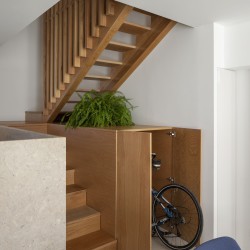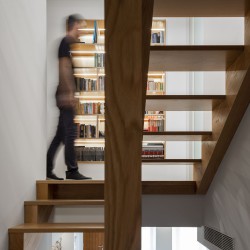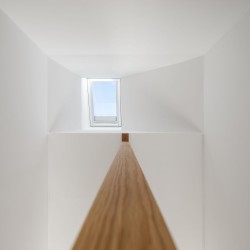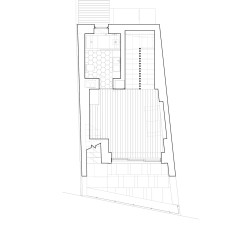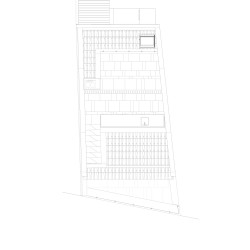ESQUISSOS – Arquitectura e Consultoria . photos: © Ivo Tavares Studio
One of the biggest challenges of this project was the small dimensions of the place and the already consolidated surroundings. There so, the relations between scale and proportion were since the beginning a main concern. Using a clean language with contemporary details that result from a reinterpretation of language and traditional materials from the village of Cascais, the building is integrated with the others on the street’s elevation. Therefore, it preserves the local identity and the original lines, respecting the memory of the place.
The building works in four different levels; three of them are connected by a stair that stands as a sculpture, being a part of the architectural path. This stair starts as a part of the furniture and, as it goes up, it starts to dematerialize, allowing a more permeable relationship between levels in order to have a better use of space and light. The areas are ample, especially on the 1st floor – at street level – where it works as an open-space, leading to the feeling of spacious and benefiting in terms of useful areas. The bedrooms and bathrooms are in the intermediate floors. The third level has a recessed balcony, which gives access to the last level, where we find a terrace, the result of the subtraction of matter.
_
Nome do Projeto: Casa GD
Escritório: ESQUISSOS – Arquitectura e Consultoria
Arquiteto responsável: Arqº. Marco Ligeiro
Localização do Escritório: Sintra, Portugal
—
Localização da obra: Cascais
Ano de conclusão da obra: 2019
Área total construída (m2): 131,00 M2
Programa: Reabilitação de Moradia Unifamiliar
—
Arquiteto Líder: Arq.º Marco Ligeiro
Fotógrafo: Ivo Tavares Studio
Arquitetos Responsáveis: Marco Ligeiro
Equipe de Projeto: André Caetano, Gabriela Garcia, Luís Pereira
Engenharia: André Pardal, João Jorge
Construtores: Construções Gouveia & Lourenço
Fabricantes: Fenesteves, Motherstudio, Carpintaria Casanova, Bruma, Sanindusa
Um dos maiores desafios desta reabilitação foram as dimensões reduzidas do lote e a envolvente consolidada, assim sendo, a relação entre escala e proporção foi desde o início um compromisso. Recorrendo a uma linguagem depurada com pormenores de contemporaneidade que resultam de uma reinterpretação da linguagem e das matérias aplicadas tradicionalmente na vila de Cascais, o edifício ergue-se de forma uniforme na frente rua, mantendo a identidade cascalense e as linhas originais, respeitando o imaginário da envolvente. A edificação funciona em quatro níveis diferentes, três deles unidos por uma escada que se afirma como peça escultórica que faz parte do percurso arquitetónico; esta escada é inicialmente contígua ao mobiliário mas, conforme a ascensão, vai se desligando e tendo uma aparência mais leve, permitindo uma relação mais permeável entre os níveis. De forma a haver um maior aproveitamento de espaço e luz, as áreas são bastante amplas, especialmente no piso 1, ao nível da rua, onde o espaço é completamente aberto, criando a sensação de amplitude e beneficiando em termos de áreas úteis. Nos pisos intermédios desenvolvem-se quartos e casas de banho, sendo o terceiro piso dotado de uma varanda recuada, que permite o acesso ao último nível, onde encontramos um terraço, resultado da subtração de matéria, “escavado” na cobertura inclinada tradicional.






